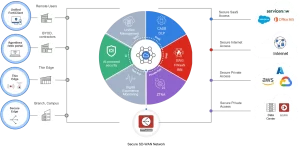As hybrid work models become permanent, organizations face an uphill battle to secure distributed networks while maintaining operational agility. Traditional security tools struggle to keep pace with the fluidity of remote and on-premises environments, leaving critical data exposed. Enter Fortinet’s FortiSASE platform, now fortified with advanced security features and streamlined management capabilities designed to protect hybrid infrastructures without compromising user experience. This article explores how FortiSASE is setting a new standard for secure, scalable network access in today’s fragmented IT landscape.
The Growing Challenge of Hybrid Environments
Hybrid workplaces demand seamless connectivity across cloud services, on-site resources, and endpoints spread across geographies. However, this flexibility often comes at a cost: increased attack surfaces, inconsistent policy enforcement, and complexity in monitoring threats. For instance, a global retail chain recently reported a 30% spike in phishing-related breaches after expanding its remote workforce, highlighting gaps in legacy security architectures.
Fortinet’s FortiSASE addresses these vulnerabilities by extending next-gen firewall (NGFW) capabilities to the edge of the network. Unlike traditional VPNs or SD-WAN solutions, FortiSASE delivers granular visibility and control over user activity, regardless of location. A financial institution, for example, reduced unauthorized access attempts by 85% after deploying FortiSASE, thanks to its context-aware access policies that factor in device health, user role, and real-time threat intel.

[A dynamic infographic showing FortiSASE’s layered security architecture, with icons representing encryption, threat detection, and policy enforcement. Caption: “FortiSASE integrates security directly into the network edge, ensuring protection spans every connection.”]
Unified Policy Management: Streamlining Security Across Domains
Managing security policies across hybrid environments is notoriously complex. IT teams often juggle multiple dashboards to enforce rules for cloud apps, on-premises servers, and remote users. FortiSASE simplifies this with centralized policy orchestration, enabling administrators to define and enforce rules from a single interface.
Key innovations include:
- Automated Compliance Checks: Align with regulations like GDPR or HIPAA by automatically flagging misconfigured devices.
- AI-Driven Threat Response: Machine learning analyzes traffic patterns to detect anomalies (e.g., ransomware payloads) in real time.
- Seamless SD-WAN Integration: Prioritize critical applications like VoIP or video conferencing while enforcing QoS policies.
A healthcare provider reduced policy audit preparation time from weeks to hours after adopting FortiSASE’s unified console, ensuring HIPAA compliance without disrupting patient care workflows.
Zero Trust at Scale: Beyond the Buzzword
While “zero trust” has become a buzzword, FortiSASE operationalizes it through continuous authentication and micro-segmentation. Every user and device must prove legitimacy before accessing resources—and privileges are revoked instantly if threats emerge. For example, a manufacturing firm prevented a lateral movement attack by isolating a compromised IoT sensor within milliseconds, thanks to FortiSASE’s automated response protocols.
The platform also integrates with Fortinet’s Security Fabric, enabling cross-platform threat intelligence sharing. This ecosystem approach ensures that firewalls, endpoints, and email gateways work together to neutralize attacks before escalation.
Future-Proofing Hybrid Networks
To maximize FortiSASE’s value, organizations should prioritize three steps:
- Conduct a Network Audit: Identify shadow IT and legacy systems that could bypass security controls.
- Adopt a Zero Trust Framework: Use FortiSASE’s granular policies to enforce least-privilege access.
- Leverage Cloud-Delivered Updates: Ensure protection stays current with automated firmware and threat signature updates.
Real-World Impact: A Case Study in Resilience
When a multinational logistics company faced a surge in remote cargo tracking requests, their VPN infrastructure buckled under latency and security gaps. By migrating to FortiSASE, they achieved:
- 99.9% uptime for global users.
- 50% faster threat containment via automated response workflows.
- A 40% reduction in bandwidth costs through optimized traffic routing.
The company’s CISO, Maria Gomez, emphasized, “FortiSASE didn’t just fix our connectivity issues—it gave us confidence to scale operations without sacrificing security.”
Conclusion: Security That Adapts to Your Hybrid Reality
Fortinet’s FortiSASE isn’t just another security tool—it’s a strategic enabler for hybrid workforces. By merging simplicity with enterprise-grade protection, it allows organizations to focus on innovation rather than infrastructure fragility. In an era where breaches cost an average of $4.45 million globally (IBM, 2023), platforms like FortiSASE aren’t optional; they’re foundational.
As hybrid models evolve, so too must the tools we rely on. FortiSASE’s blend of edge-to-core security and intelligent automation positions it as a leader in the next generation of network protection. For businesses ready to thrive in the hybrid era, the future is here—and it’s secure, seamless, and scalable.

Leave a comment